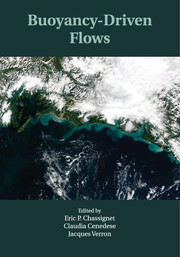Book contents
- Frontmatter
- Contents
- List of Contributors
- Introduction
- 1 Gravity currents – theory and laboratory experiments
- 2 Theory of oceanic buoyancy-driven flows
- 3 Buoyancy-forced circulation and downwelling in marginal seas
- 4 Buoyant coastal currents
- 5 Overflows and convectively driven flows
- 6 An ocean climate modeling perspective on buoyancy-driven flows
- 7 Buoyancy-driven currents in eddying ocean models
- 8 Atmospheric buoyancy-driven flows
- 9 Volcanic flows
- 10 Gravity flow on steep slope
- Index
- Plate section
- References
4 - Buoyant coastal currents
Published online by Cambridge University Press: 05 April 2012
- Frontmatter
- Contents
- List of Contributors
- Introduction
- 1 Gravity currents – theory and laboratory experiments
- 2 Theory of oceanic buoyancy-driven flows
- 3 Buoyancy-forced circulation and downwelling in marginal seas
- 4 Buoyant coastal currents
- 5 Overflows and convectively driven flows
- 6 An ocean climate modeling perspective on buoyancy-driven flows
- 7 Buoyancy-driven currents in eddying ocean models
- 8 Atmospheric buoyancy-driven flows
- 9 Volcanic flows
- 10 Gravity flow on steep slope
- Index
- Plate section
- References
Summary
Introduction
Relatively fresh river or estuarine water entering the coastal ocean forms a buoyant plume that often turns anticyclonically (to the right in the Northern Hemisphere) and forms a buoyant gravity current that can flow large distances along the coast before dispersing (e.g., Mork 1981; Munchow and Garvine 1993a; Rennie et al. 1999; Royer 1981). The tendency for the buoyant water to turn and flow along the coast as a relatively narrow current is a consequence of Earth's rotation. The focus here is on two aspects relevant to buoyant gravity currents in the ocean: (1) determining the characteristics of buoyant coastal currents flowing along a sloping bottom and (2) determining the influence of wind forcing on buoyant coastal currents.
Buoyant coastal currents are important components of the circulation on most continental shelves (e.g., Simpson 1982; Hill 1998). Buoyant coastal currents also transport constituents, such as sediment, marine organisms, nutrients, and chemical pollutants large distances from their river or estuarine sources. Therefore, determining the ultimate distribution and fate of these constituents depends on understanding buoyant coastal currents and their alongshore range of influence (e.g.,Wiseman et al. 1997; Epifanio et al. 1989). Two examples of societal problems where buoyant coastal currents play an important role are hypoxia and abrupt climate change.
Hypoxia is dissolved oxygen concentrations that are reduced to a level that is detrimental to marine organisms. Hypoxia associated with nutrient transport from rivers to the coastal ocean is a global problem (Diaz 2001).
- Type
- Chapter
- Information
- Buoyancy-Driven Flows , pp. 164 - 202Publisher: Cambridge University PressPrint publication year: 2012
References
- 2
- Cited by



